DA 42 In The Second Generation
The Diamond Twin Star now has its own Austro AE300 turbo diesel engines
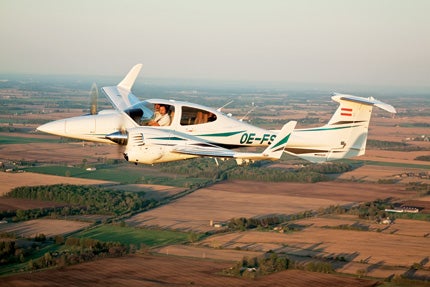 In seeming obedience to the time-honored directive on how to make a small fortune in the airline industry (start with a large one), the major people movers of the world are having a progressively more difficult time staying in business. From the purveyors of all cheap seats to those with additional classes of expensive buckets, only a continuing series of consolidations has rescued several of the major lines from having to park their airplanes in the desert sun and try some other line of work. We can only wonder how long it will be before, no matter what the destination or stage length, we'll all be flying on either Unideltamerica or Britluftqantas.
In seeming obedience to the time-honored directive on how to make a small fortune in the airline industry (start with a large one), the major people movers of the world are having a progressively more difficult time staying in business. From the purveyors of all cheap seats to those with additional classes of expensive buckets, only a continuing series of consolidations has rescued several of the major lines from having to park their airplanes in the desert sun and try some other line of work. We can only wonder how long it will be before, no matter what the destination or stage length, we'll all be flying on either Unideltamerica or Britluftqantas.
Perhaps surprisingly, the pilot market to fly such aircraft is still fairly strong. Airline flying may not be what it once was, but it's still near the peak of the aviation pyramid. Pay is good, time off is plentiful and perks are generous. Airline flying remains perhaps the most sought-after and competitive job in aviation, and the universal means to that end is a commercial/ATP license, an instrument rating and a multi-engine ticket.
These days, there are three new models of twin-engine aircraft amenable to the trainer role, all readily available to the UNDs and Embry-Riddles of the world: the recently introduced Tecnam P2006T, still something of a newcomer in the industry; Piper's evergreen Seminole, the preeminent twin trainer in intermittent production since 1978; and Diamond Aircraft's DA42 Twin Star.
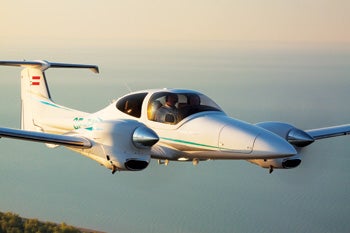 Classroom Or Boardroom
Classroom Or Boardroom
Of these, the Diamond Twin Star is perhaps equally applicable to both the owner-flown and training market. By now, most pilots know the story of the Twin Star's growing pains, but even the original airplane was an excellent adaptation to the multi-engine training role and the owner-flown market.
Diamond Aircraft, based in Weiner Neustadt, Austria, marketed the majority of its airplanes in places where avgas already was becoming scarce, so it was no big surprise that the first Twin Star featured a pair of FADEC-controlled Thielert turbo diesels. These engines are operationally closer to jets than to piston powerplants in all aspects except price, and they're designed specifically to burn jet fuel. Perhaps ironically, the turbo diesel engines aren't certified to burn diesel fuel (assuming you could find any at airports).
A Different Breed Of Twin Star
A Lycoming-powered version of the Twin Star, the DA42-L360, features a 180 hp piston engine on each wing. It offers similar performance to the DA42-NG, and many of the type will undoubtedly find favor on this side of the Atlantic, especially on the owner-flown market, in areas where avgas availability isn't a problem. The primary product will likely remain the DA42-NG with the Austro 168 hp turbo diesels installed, perhaps the better choice for operation overseas where avgas is scarce and often pricey.
Austro Engines GmbH was specifically established in 2007 to certify and produce the AE-300 turbo diesels in conjunction with technology partners Mercedes-Benz Tech and Bosch. The new powerplants are similar in concept to the Thielerts they replace, but there are some notable improvements. The gearbox now offers a design life of 2,000 hours, though TBO remains 1,000 hours at this writing. Diamond mounts the new Austros with a four-point rather than the three-point mount used on the TDI. The crankcase is now cast iron versus aluminum, better suited for the higher power output. Improved turbo and induction air efficiency increases critical altitude to improve high-altitude climb and cruise performance. An integral oil coolant/heater exchanger eliminates external oil lines and oil cooler. Overall, it's a highly refined package of engine power components.
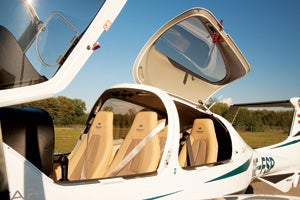 Twin Stars of any description have always looked like something Luke Skywalker might fly, with tall T-tails and fancifully swept winglets gracing both tips, lending end-plate effect to lift. There's also a large ventral fin beneath the waspish empennage. It's an imposing airplane from the front view with a big, 44-foot-wide wingspan. (Try to fit that into a standard T-hangar.) The wing is a very high-aspect-ratio design (short chord, wide span), similar to Diamond's other models that emphasize gliding efficiency.
Twin Stars of any description have always looked like something Luke Skywalker might fly, with tall T-tails and fancifully swept winglets gracing both tips, lending end-plate effect to lift. There's also a large ventral fin beneath the waspish empennage. It's an imposing airplane from the front view with a big, 44-foot-wide wingspan. (Try to fit that into a standard T-hangar.) The wing is a very high-aspect-ratio design (short chord, wide span), similar to Diamond's other models that emphasize gliding efficiency.
The diesel engines seem almost outsized compared to the Lycoming version, not surprising since diesels generate more heat, are structurally larger and are about 40 percent heavier than comparable piston mills.
Inside, fittings and materials are so plush and comfortable, it's clear that this is more than merely a trainer. Leather is everywhere, and the airplane is fitted out as nicely as a BMW sport sedan.
The DA42 was obviously designed for both flight training and the owner-flown market. With the large, two-screen Garmin G1000 gracing the panel, businesslike, center-stick roll and pitch controls (rather than side sticks) and single-lever power controls that combine throttle, propeller and mixture management, the DA42-NG easily side-steps any criticism that the design is entrenched in the last century.
Flying The DA42-NG
Diamond's Rob Johnson doesn't look like Luke Skywalker, but he's the lucky, designated demo pilot on the DA42, and he knows the new airplane perhaps better than anyone else. A former Cathay Pacific captain on 747s, Johnson has a variety of experience in everything from military to airline to general aviation, a perfect candidate for demonstrating the talents of Diamond's new Twin.
Rob talked me through engine start, easier than a piston process and less critical than a jet because of the FADEC system. The glow plug trick takes only a second or two, and of course, there's no such thing as a hot start a la turbines.
Gross weight on the new NG is 4,189 pounds against a basic 3,119-pound empty weight. This is before options such as FIKI (Flight Into Known Icing), TCAS, Stormscope and air conditioning (not yet available). Still, pure payload calculates at 553 pounds. Even reduced for the inevitable options most people buy, a typical DA42-NG should score about 525 to 550 paying pounds.
That's not a problem for a student and instructor, but it's also a fair number for Mom, Dad and two small kids in back. Diamond is wisely pitching the new DA42 as both a power-redundant family/business transport and a multi-engine teaching machine, and the airplane would appear to have legs for either mission.
With nearly 340 hp worth of turbocharged enthusiasm, Johnson's DA42-NG demonstrator came off the line and scored an easy 1,300 fpm pointed uphill with two up and about three-quarters fuel in the 76-gallon tanks.
Critical altitude on the turbo diesels is 14,000 feet, and if oxygen masks are your bag, you can fly at the full 92-percent setting and see 180 knots cruise, or run a full 75-percent cruise setting at 174 knots TAS in exchange for 13.6 gph total. That works out to an sfc (specific fuel consumption) of .37 lbs./hp/hr. Most piston engines score an sfc of .40 lbs./hp/hr. or higher, so the Austro turbo diesel starts right off with a seven- to eight-percent advantage.
At 60-percent power, expect more like 152 knots burning 10.3 gph. With a useable 76 gallons in the tanks at the latter setting, the NG can endure for an easy five hours plus reserve for a range of 700-750 nm. Lesser power settings can extend that to over 1,000 nm. Diamond specifically brags of an 1,180 nm range at long-range cruise.
Johnson and I launched at the conclusion of Sun ’n Fun 2010 in Lakeland, Fla., then flew up and away to the southeast to clear traffic in the Tampa/St. Pete Class B. (Remember when they used to be called TCAs, Terminal Control Areas, a phrase that actually meant something?) With Johnson as my security blanket and 5,000 feet of altitude, I tried a Vmc demonstration right into the stall. Johnson didn't object, so I shut down one engine, applied full power on the other and pulled the airplane up into the stall. The result was a notably undramatic roll toward the dead engine, nothing very exciting and easy to correct.
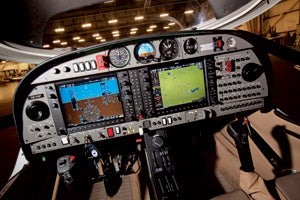 Gentle Handling
Gentle Handling
The Twin Star's docile nature was the subject of some debate during FAA certification on the premise that the airplane was TOO easy to fly in single-engine mode, as if any twin could be too safe. The reality is that every aspect of the Twin Star's personality flies in the safe zone. Low-end performance is excellent, configured for the pilot who would rather not have to worry about performance at the top or the bottom of the envelope. Vmc roll and dirty stall are pretty much simultaneous, so single-engine manners are as benign as it's possible to make them.
All The Right Moves
With standard VGs, the Twin Star can be driven down final as slow as 73 knots and transition to full stop on the runway in as little as 1,300 feet. Combine that with a 1,600-foot takeoff run, and it's apparent a well-practiced pilot can ground the Twin Star and return to the sky from airports as short as 2,000 feet.
Price is always subjective. In this case, the subjective part costs a base $679,575. As a trainer, the DA42-NG sports good economy, one of the most comfortable cabins in (or out of) the class, FADEC automation that reduces operational procedures to their simplest form and handling that should make it easy for anyone to earn their twin rating.
| Your Choice Of Diamonds |
|
Diamond produced the HK-36 Super Dimona powered glider starting in early 1990, but that model was rarely exported to this side of the Atlantic. The first Diamond most Americans experienced was the '95 model DA20-A1 Katana, a T-tailed trainer powered by an 81 hp, Rotax 912F3 engine. This evolved to become the DA20-C1 Evolution, a Continental-IO-240B-powered airplane and pretty much the industry's only dedicated trainer in the late ’90s. The DA20-C1 Eclipse continues as the company's basic trainer. Diamond's initial Skyhawk/Skylane competitor was the DA40-180 Star, a generous four-seater with the popular, 180 hp, IO-360 Lycoming driving a fixed-pitch prop out front and a left back door for loading rear-seat passengers. The DA40 also is being offered with a diesel powerplant. Diamond began experimenting with the DA50 Magnum model in 2007, a big-power (310-350 hp) five-seater intended to compete with the Cirrus SR22 and the Cessna Corvalis models head-to-head. The DA50 is still under development. The DA42-TDI was Diamond's first attempt at a diesel- powered twin trainer and now continues as the DA42-NG with the new Austro diesel engines. For avgas fans, there's also a Lycoming IO-360 version. Finally, Diamond is well along on development of the D-Jet, a single-engine, five-seat turbine specifically designed to fly in the bottom 25,000 feet of sky. The D-Jet utilizes a single Williams FJ33-4A-19 rated for 1,900 pounds of thrust. Diamond hopes to certify the D-Jet and bring it to market in 2011 or 2012. |

Subscribe to Our Newsletter
Get the latest Plane & Pilot Magazine stories delivered directly to your inbox

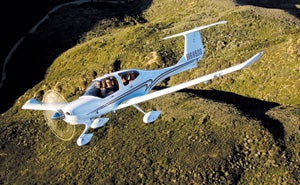 There's a variety of other Diamonds to choose from. Indeed, Diamond has become second only to Piper in producing perhaps the most diverse and varied product line.
There's a variety of other Diamonds to choose from. Indeed, Diamond has become second only to Piper in producing perhaps the most diverse and varied product line. 



